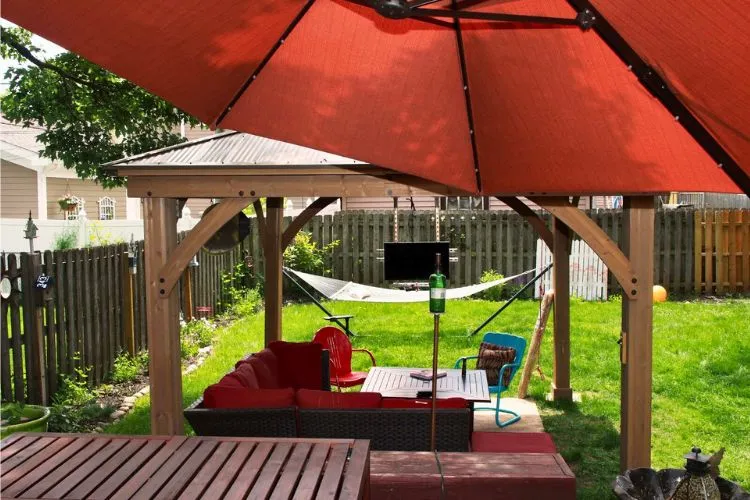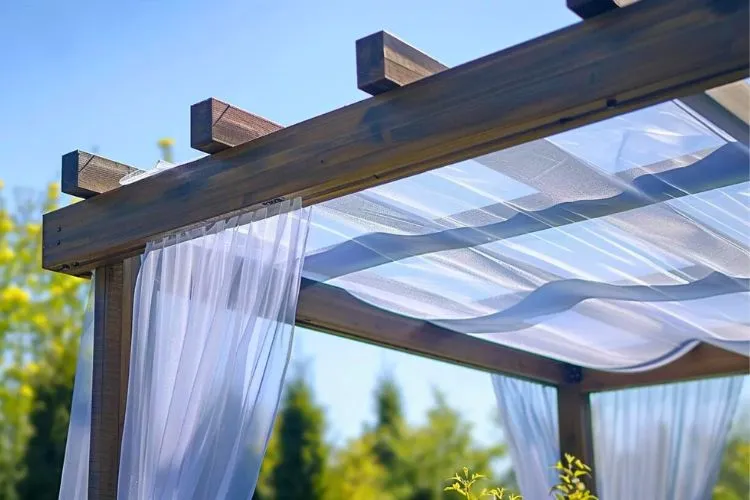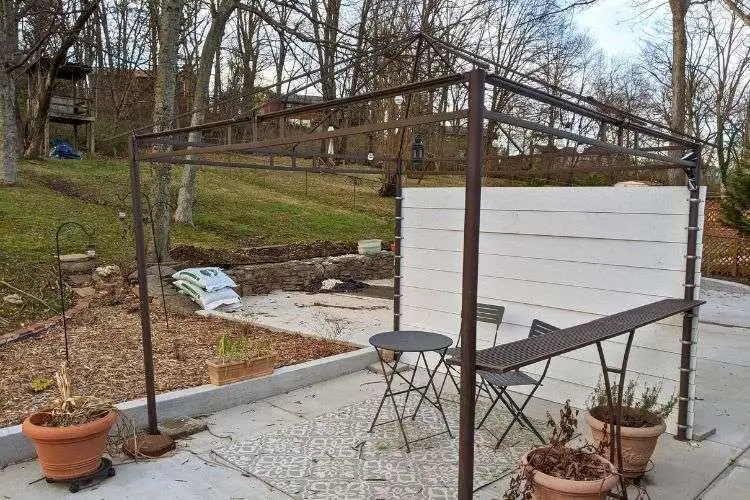Gazebos are a staple in many gardens and outdoor spaces, offering shelter and aesthetic appeal. They come in various designs, materials, and sizes, serving multiple purposes from hosting gatherings to providing a quiet space for relaxation.
A common question that arises is can gazebos be used in the rain? This article delves into the practicality of using gazebos in the rain and offers advice on how to ensure they remain a comfortable haven, regardless of the weather.

Contents
- 1 Understanding Gazebo Construction
- 2 Types of Gazebos and Rain Resistance
- 3 Waterproofing Your Gazebo
- 4 Can Gazebos Be Used in the Rain?
- 5 Gazebo Maintenance in Rainy Climates
- 6 Safety Concerns and Precautions
- 7 Enhancing the Rainy Day Gazebo Experience
- 8 After the Rain: Assessing and Addressing Damage
- 9 Types of Waterproof Materials
- 10 Frequently Asked Questions (FAQs)
- 10.1 How do I prevent water from pooling on my gazebo roof?
- 10.2 Can I install a gutter system on my gazebo to manage rainwater?
- 10.3 Are there any waterproof covers available for gazebos?
- 10.4 How often should I reapply waterproof treatments to my gazebo?
- 10.5 What precautions should I take if I want to use a heater in my gazebo on rainy days?
Understanding Gazebo Construction
The construction of a gazebo greatly influences its ability to withstand rainy conditions. Materials such as wood, metal, and vinyl are commonly used, each with its level of rain resistance.
Wooden gazebos, for example, offer a classic look but require treatments to prevent water damage. Metal gazebos, on the other hand, are robust but may develop rust if not properly coated.
Vinyl structures are inherently water-resistant and need minimal maintenance. The design of a gazebo, including its roof and drainage systems, plays a crucial role in its functionality during wet weather.
Types of Gazebos and Rain Resistance
Traditional Gazebos
Constructed from wood or metal, traditional gazebos are often equipped with features to manage rainfall, such as sloped roofs that direct water away from the structure.
With proper maintenance and waterproof treatments, these gazebos can provide shelter from the rain without succumbing to damage.
Pop-Up Gazebos
Pop-up gazebos are lightweight and portable, offering a convenient option for temporary outdoor shelter. While they can provide immediate cover from rain, their lighter construction and materials mean they are less suited to withstand heavy downpours or prolonged exposure to wet conditions.
Permanent vs. Semi-Permanent Structures
Permanent gazebos are designed to endure all weather conditions, including heavy rain. They are typically more robust, featuring materials and construction that offer greater protection.
Semi-permanent gazebos, while still offering some level of rain resistance, may not fare as well under intense or continuous rainfall, necessitating additional waterproofing measures.
Waterproofing Your Gazebo
Waterproofing is key to maintaining a rain-friendly gazebo. Roofing materials such as asphalt shingles, metal, or PVC provide durable, waterproof covers that protect the structure and its occupants.

Regular inspections and maintenance, such as sealing wood and treating metal for rust, are crucial to preserving the gazebo’s integrity and functionality in wet weather.
Can Gazebos Be Used in the Rain?
Ensuring that your gazebo remains a comfortable retreat during the rain involves more than just waterproofing.
Consider installing weather-proof side panels or curtains to provide additional shelter from wind-driven rain. Proper sealing and timely maintenance checks help in identifying and addressing potential issues before they escalate.
Gazebo Maintenance in Rainy Climates
In areas prone to frequent rainfall, regular maintenance is vital to prevent rust, rot, and mold.
After heavy rains, inspect your gazebo for any signs of water damage or pooling and address these promptly. Keeping the area around the gazebo well-drained also helps in minimizing water exposure.
Safety Concerns and Precautions
Using a gazebo during the rain comes with safety considerations, especially if the structure is wired for electricity. Ensure that all electrical installations comply with safety standards and consider using waterproof covers for sockets and switches.
Additionally, avoid using electronic appliances in the gazebo during wet conditions unless they are specifically designed for outdoor use.
Enhancing the Rainy Day Gazebo Experience
Creating a cozy and inviting atmosphere in your gazebo, even during rain, is possible with a few adjustments. Comfortable, waterproof furniture, soft lighting, and warm blankets can transform the space into a snug refuge from the dreary weather.
You may also find useful: Are Gazebos Covered by Insurance? | How Long do Gazebos Last?
After the Rain: Assessing and Addressing Damage
Following a bout of rainy weather, take the time to assess your gazebo for any damage. Look for leaks, sagging parts, or any wear that may have occurred.

Promptly repairing these issues not only extends the life of your gazebo but also ensures it’s ready for its next use, rain or shine.
Types of Waterproof Materials
In gazebo construction, waterproof materials are paramount for longevity and usability in wet conditions. Vinyl is a popular choice due to its inherent water resistance, low maintenance, and durability, but it may lack the aesthetic appeal of natural materials.
Treated wood, such as cedar or redwood, offers traditional beauty and can be highly water-resistant when properly sealed, although it requires regular maintenance to prevent rot.
Metal gazebos, made from aluminum or steel, provide strength and resistance to decay; however, they must be coated to prevent rust. Each material presents a trade-off between aesthetics, maintenance, and cost, allowing individuals to choose based on their priorities and the climate they live in.
Frequently Asked Questions (FAQs)
How do I prevent water from pooling on my gazebo roof?
Ensure the roof is properly sloped and consider adding gutters or drainage systems to direct water away from the structure.
Can I install a gutter system on my gazebo to manage rainwater?
Yes, gutters can be a practical addition to aid in water management, especially for gazebos located in areas with heavy rainfall.
Are there any waterproof covers available for gazebos?
Various waterproof covers are designed to fit different gazebo sizes and shapes, providing an additional layer of protection against rain.
How often should I reapply waterproof treatments to my gazebo?
This depends on the material of your gazebo and the climate, but typically, treatments should be reapplied every one to three years.
What precautions should I take if I want to use a heater in my gazebo on rainy days?
Ensure the heater is designed for outdoor use, keep it away from wet surfaces, and follow all manufacturer’s safety instructions to prevent accidents.
Conclusion:
Gazebos can indeed be used in the rain, provided they are properly constructed, maintained, and equipped to handle wet conditions.
Whether your gazebo is a permanent fixture or a temporary setup, taking the necessary precautions and performing regular maintenance will allow you to enjoy your outdoor retreat in any weather.
By understanding the materials, construction, and necessary preparations, owners can ensure their gazebos remain functional and inviting spaces, even during a downpour. Rain need not spell an end to outdoor enjoyment; with a bit of planning, your gazebo can offer a cozy sanctuary amid the showers.

Sergio Gomes, a passionate advocate for outdoor living and the male voice behind Shades Authority. With years of experience, Sergio is your trusted source for expert insights on gazebos, pavilions, cabanas, pergolas, and all things outdoor shade solutions. Join him on a journey to transform your outdoor spaces into stunning, functional retreats
